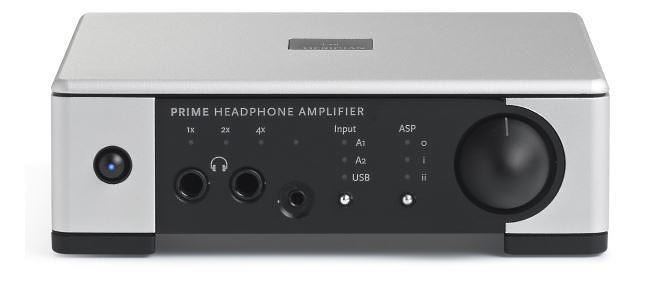Well, I guess everyone knows by now that the Digital Entertainment Group (“DEG”), in cooperation with the Consumer Electronics Association (“CEA”) and The Recording...
Read More »
Recent Articles
The New High Resolution Standard
Audio Shows. At Hotels?
Having just come back from what I think is my twenty-second audio show in five years (each time swearing I’ll never attend another one),...
Read More »
Recent Shows
T.H.E. Show (Newport Beach) 2014 Coverage
Initial Impressions THE Show (Newport Beach) 2014 was a breath of fresh air (at least to the extent that fresh air and traipsing up...
Read More »
CES 2014 Coverage
High-end audio companies are apparently abandoning CES in droves. A few years ago, manufacturers were spread across five floors at the Venetian - 29,...
Read More »
Recent Reviews
dCS Vivaldi DAC Review
I think it is fair to say that in the eighteen or so months it has been on the market, the dCS Vivaldi has...
Read More »
AURALiC TAURUS Balanced Output Headphone Amplifier Review
Several months ago I reviewed the AURALiC VEGA DAC, and found it to be a tremendous performer and exceptional value. In fact, the only...
Read More »
Manufacturer Links
Meridian Prime USB DAC and Headphone Amplifier Review
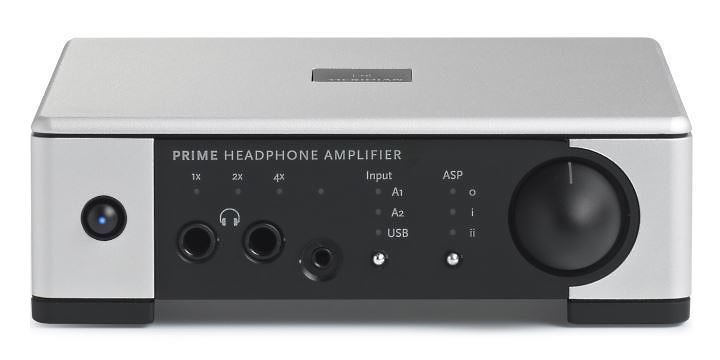
Meridian makes some very expensive state-of-the-art components, including the 808.5 CD player ($22,000), 818v2 digital preamplifier ($16,000), 861v8 surround sound processor ($25,000), and DSP8000.2 digital active loudspeakers ($65,000/pair). What is interesting is that Meridian’s emphasis over the past 12 months has been on releasing more affordable products, both to compliment their reference components and to reach a broader audience, including the Explorer portable USB DAC and headphone amplifier ($299) and Director DAC ($699), both of which I have reviewed favorably. Current Meridian users haven’t been left out either. They received the Media Source 200 endpoint ($1000), which allows inexpensive multi-room distribution of Meridian’s digital music streaming system (formerly known as Sooloos).
Now Meridian has released the Meridian Prime USB DAC and headphone amplifier ($1999), which, as an added bonus, also has analog preamplifier functionality. Meridian aficionados have been clamoring for headphone capability for ages, so they are going to be ecstatic. The good news, however, is that the Meridian Prime, like the Explorer and the Director before it, is not intricately tied to Meridian’s proprietary eco-system, but is available to be used, either by itself or as a part of a larger audio system, by non- Meridian users as well. And the more die-hard audiophiles will be really impressed to learn that Meridian is contemporaneously releasing an optional dedicated 12-volt linear power supply, cleverly named the Meridian Prime Power Supply ($1250), to wring the best possible performance out of the new Meridian Prime headphone amplifier. Without further ado, let’s take a look at Meridian’s new offerings.
Meridian Prime Headphone Amplifier
Out of the box, I was surprised at how compact the Meridian Prime is. It measures approximately 6″ wide by 6″ long by 2″ high, and weighs a scant two pounds. Though small and light, it is exceptionally well made, using interlocking extruded aluminum panels with nary a screw showing. Apparently, it is disassembled by moving a hidden magnetic latch using a special tool. I was baffled in my efforts at opening it for a closer look. The finish is bead-blasted aluminum with black composite accents, matching Meridian’s G-series components as well as Apple’s MacBook Pro and iPad.
The front panel is bristling with controls. On the far left is the power button. When power is off, it glows blue; when power is on, it glows white; when you press and hold it, it glows green and disables the preamplifier outputs on the rear. Moving to the right, there are three headphone jacks, two ¼ inch and one 3.5mm, which encourages sharing the headphone listening experience. In addition, using the two ¼-inch jacks and a special headphone cable available for many higher-end headphones, you can listen in balanced mode. Now that’s well thought out. Above the headphone jacks are three white LEDs indicating the incoming sampling rate (1x, 2x, 4x). In the center are two push-buttons with three white LED indicators in vertical columns above them for selection of inputs (USB, A1 and A2) and selection of headphone processing (O, i, ii), about which I’ll have more to say in a moment. Finally, all the way to the right is a large volume control whose linkage to the internal potentiometer is flexible and damped to reduce microphonics.
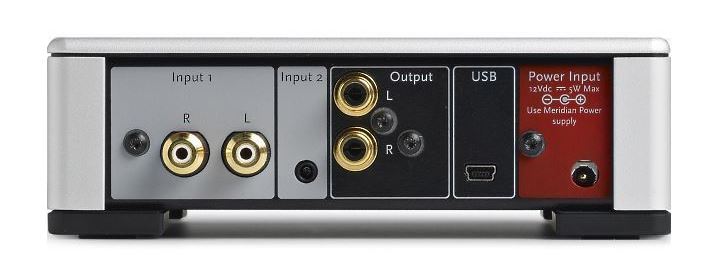
Around back, the layout is much simpler. There are two analog inputs, one on gold-plated RCA jacks for connection to tradition sources, and the other on a 3.5mm mini-jack for connection to, say, an iPod or iPhone dock. In addition, there is a digital input on mini-USB. There are also two gold-plated RCA analog output jacks for connection either to a preamplifier or directly to a power amplifier, which is how I had it set up in my system. Finally, there is a 12-volt DC input for connection either to a wall-mounted modular power supply, which comes with a selection of AC travel adapters, or to the Meridian Prime Power Supply.
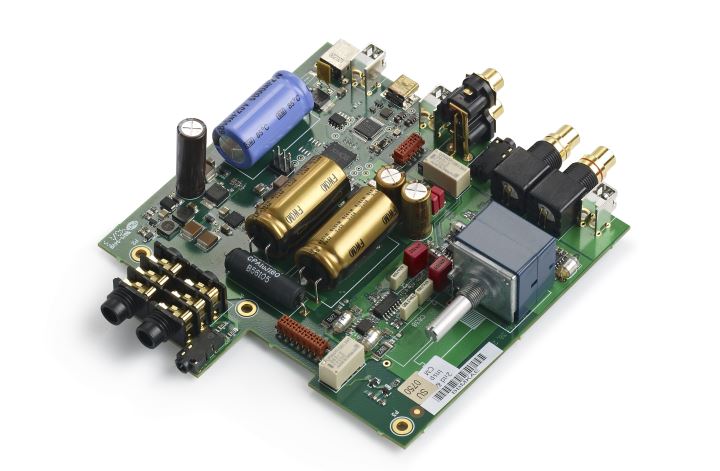
Inside, the central portion of the six-layer PCB is a doppelgänger of the Meridian Director DAC. The Meridian Prime shares with the Director the XMOS ‘L2′ asynchronous USB interface and digital signal processor, 32-bit, 384kHz CM4353 DAC chip, carbon film resistors, and Nichion and WIMA capacitors. As with the Director, the Meridian Prime can accept digital inputs up to 24-bit, 192kHz, and upsamples all 44.1kHz/48kHz signals to 88.2kHz/96kHz using Meridian’s proprietary apodising filter, bypassing the linear reconstruction filter on board the CM4353. The left side of the PCB is devoted to filtering and regulating the incoming DC power. The right side of the PCB contains all of the analog circuitry for driving the headphone and preamplifier outputs, and for implementing Meridian’s proprietary headphone processing. Notably, volume control is in the analog domain, relying on a fine, and buttery smooth, ALPS potentiometer.
Analog Spatial Processing
Bob Stuart has degrees in both electrical engineering and psychoacoustics. Who better to address the problem that has long plagued headphone listeners, that of the internalization and lateralization of the sound image along an imaginary line between the ears. The issue is that when listening to loudspeakers, the sound from the left speaker and reflections from the left side of the room arrive at the left ear earlier, with greater intensity, and with a different frequency response than at the right ear, and vice-versa for the right speaker and right side reflections. This is known as inter-aural delay, and allows the ear to discern the location and distance of the sound source, and the size of the room. It is also what is responsible for creating the phantom image in stereo. With headphones, inter-aural delay is nil, which causes the soundstage to collapse into the center of your head, something which I find disconcerting when listening to headphones at length, though it is tolerable when working out, commuting by bus, and traveling by plane There is simply no ability for the mind to create a sonic (and visual) image of the performers in front of you. The result is music that, while extraordinarily detailed and free from frequency response anomalies resulting from the speakers’ interaction with the room, ultimately remains unconvincing. Bob Stuart has tackled the problem and devised an analog circuit to make headphone listening closer to the experience of listening to loudspeakers, in fact two options from which to choose, according to your preference. I am surprised that is something which is virtually never addressed in even the most expensive headphone amplifiers.
Meridian Prime Power Supply
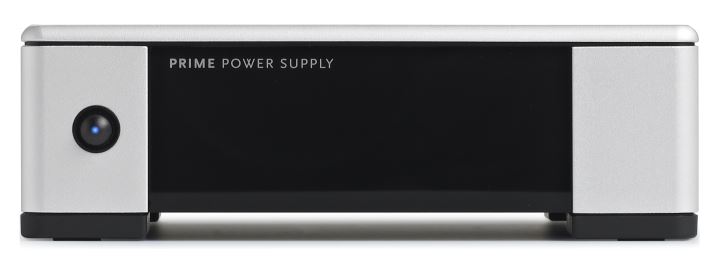
I also had an opportunity to evaluate a prototype of the Meridian Prime Power Supply. As delivered to me, it is the same elegant design, construction and diminutive size as the Meridian Prime, but weighs in at a sturdy 3.5 pounds, nearly twice the weight of headphone amplifier itself. It is one solid unit. The front panel is bereft of any controls other than the of/off button, which, like on the Meridian Prime, glows blue when in standby and white when on. The action is on the back panel, where you find the power inlet, USB digital input pass-through, and five latching 3-pin mini-DIN 12-volt DC power output connectors, which supply 500ma each. As the power supply can power the Meridian Prime headphone amplifier, Director DAC, Media Source 200 multi-room distribution endpoint, and Media Core 200 stereo audio controller, that leaves one power outlet tantalizingly free for future expansion of the product line. Since this is a linear power supply, it uses a toroidal power transformer, thus necessitating two available models, one for the 110-120 volt North American market, and another 220-240 volt unit for the rest of the world. The USB pass through connectors isolate the digital signal from the noisy power supply of the source computer. On the output side, the USB connector carries only the digital signal and ground, while power is separately supplied via the mini-DIN. The other benefit is that if no USB connection is made, the DAC remains unpowered and completely silent.
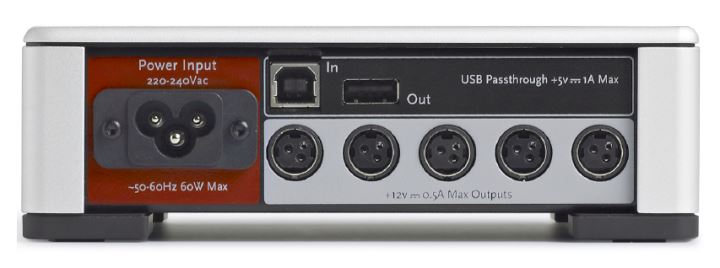
The issue of course is whether the Meridian Prime Power Supply is a worthwhile addition. To test it, with no music playing, I turned the volume up to the maximum and listened, both with my ear next to the speaker when using the Meridian Prime as an analog preamplifier, and with headphones, and could detect a marginal reduction in the noise floor. Detecting differences with music playing was much more difficult, particularly since it was impossible to do an instantaneous A/B comparison. If you purchase the Meridian Prime, I would suggest auditioning the Meridian Prime Power Supply with a return privilege to determine whether the improvement is, to your ears, commensurate with the cost. Assuming you already have an excellent pair of headphones, at this level of investment, if the final version of the product is anything like the prototype, you likely will conclude that it is. On the other hand, if your headphones are marginal, the money may be better spent on better headphones. Of course, it needn’t be an either/or proposition. Since it was available to me, I used the Meridian Prime Power Supply in all my listening sessions for the best possible performance.
Listening Impressions
Although I have a Meridian G02 fully balanced preamplifier in my system, since I acquired my dCS Debussy DAC, which has both a transparent volume control and balanced analog outputs, which drive my amplifiers directly, I use the G02 only when listening to vinyl. In other words, a preamplifier with a single analog input would suffice in my setup. The Meridian Prime has two. After careful listening, if it weren’t for the lack of remote control on the Meridian Prime, and my need as a reviewer for a fully functional preamplifier for evaluating multiple components, I would not hesitate to forego it. The Meridian Prime, used as an analog preamplifier, is that good. It is clean and quiet and simply passes the source signal along to the amplifiers without editorial comment. If you are looking for a preamplifier with a personality to fix something else in your system, you may want to look elsewhere. Significantly, acquiring the Meridian Prime also gives you the flexibility to add other sources, say, a turntable, in the future. Its preamplifier outputs also give you the opportunity to add a power amplifier and speakers as your priorities change.
Most of my listening, however, was done with with headphones. I had two pairs on hand - my Etymotic ER4-S in-ear monitors, and the Sennheiser HD800 open-back headphones I have in for review. The Etymotics worked fine, and are what I would use if I had the Meridian Prime on my bedside table, when isolation is important, but the Sennheiser HD800s are in a different league. I’ll have more to say about them in an upcoming review. Suffice it to say, just as when used as a preamplifier, the presentation of the Meridian Prime’s headphone output was quiet, clean, and neutral, and proved a revelation on many recordings, providing taunt bass, an uncolored midrange, and exceptional detail in the high frequencies. The smooth presentation lends itself to long listening sessions.
The Analog Spatial Processing works as advertised, yielding a stable image free from the ping-pong effect and performers in the middle of your head that you get with traditional headphone listening. The aural image does appear more front and center, though it can’t quite fool you into thinking the sound is physically coming from your loudspeakers, as can the technically more advanced, cumbersome and expensive Smyth Reaseach Realiser A8 audio processor. Nevertheless, it is a significant step forward. I ultimately ended up preferring setting “i” for most recordings. If your headphones tend to be a little bass shy, you may prefer setting “ii”. It also has a bit more delay, which changes the presentation somewhat. Unless your headphones require the warmth of tubes, or you just prefer basking in the glow of thermionic devices in a darkened room, the Meridian does everything you could ask of it - and then some
Whither DSD?
Where is DSD processing you may ask? Well, Bob Stuart has long thought DSD to be a fundamentally flawed digital audio storage and reproduction medium, largely due to its limited dynamic range and extraordinary amount of distortion resulting from 1-bit quantization that has to be shifted above the audible range through noise shaping, such that, despite its extremely high sample rate, its performance does not exceed the equivalent of 20 bits, and its usable frequency response is less than that of 96kHz PCM. Coupling that with the dearth of DSD recordings available for download (virtually all of which are also available as 24-bit, 192kHz sample rate files), renders DSD a niche format within an already niche market of the audiophile community. To the extent availability is growing, through Chad Kassem’s Acoustic Sounds Super HiRez website among others, it is primarily limited to the transfer of music on analog tape from the 1970s and before. And query, for new DSD releases, how many were either converted to and from PCM for mixing and mastering or upsampled from high resolution PCM files to begin with? Virtually all of them. Will the labels disclose this? I wouldn’t count on it. They deluded purchasers at the birth of SACD with hundreds (if not thousands) of discs upsampled from Redbook CDs. Why not again? This is the unvarnished truth that DSD’s vocal proponents don’t mention at audio show seminars or in blog postings. For Bob Stuart, the task was all about creating a DAC and headphone amplifier without compromise for the widest catalog of music, rather than simply jumping on the latest format bandwagon for which there is no technological advantage and content is miniscule. Moreover, the inclusion of the unique and psychoacoustically sophisticated Analogue Spatial Processing options will do more to recreate the experience of listening to live music though headphones than DSD ever will. It takes strength of character to remain intellectually honest and consistent in the face of market pressures. Bob Stuart epitomizes that virtue.
Finally, a word about the cost. Obviously, the Meridian Prime does not fall within the range of the ultra-affordable Explorer or Director USB DACs, especially when you add on the Meridian Prime Power Supply. However, Meridian had a different set of objectives in mind when developing the Prime - building the best headphone amplifier it knew how so that there would be no compromise when listening to music played back through its reference 800 series components and digital music streaming system. When compared to the other currently available combination DAC and headphone amplifiers that have true high-end pretensions, it is fairly priced, if not an outright bargain. And its Analog Spatial Processing makes it unique among the competition.
Conclusion
Don’t let its size confuse you; the Meridian Prime is a high-end component in every sense of the word - functionality, performance, and design and construction. Its built-in DAC will decode all bit depths and sample rates currently available. Sure, it doesn’t tick the currently fashionable DSD box, but, for the reasons articulated above, I view that as a failure of marketing rather than performance. Besides, you can always let your playback software, like Audivana Plus, convert DSD on the fly to 24-bit, 176.4 kHz PCM with fantastic results. The Meridian Prime’s headphone performance, particularly with Analog Spatial Processing engaged, is exemplary. The dedicated linear power supply simply takes it to the next level. And the flexibility of the Meridian Prime, with its two analog inputs and preamplifier outputs, means that it can serve as the centerpiece of an expanding system, thus protecting your investment. All in all, another world class component from a world class company, proudly designed and manufactured in its state-of-the-art facilities in the U.K. I can’t recommend it highly enough.
Now, would it be too much to ask for Meridian to offer an MC/MM phono stage in the same form factor (optionally powered by the Prime Power Supply of course) so that the new and growing generation of vinyl enthusiasts can listen to their LPs, as well as their digital downloads, in a high quality, compact system? Those RCA input jacks on the Meridian Prime, and extra power connector on the Prime Power Supply, are calling out for one.
- Frank Berryman
Specifications
Analogue Inputs
-
• 1 x 3.5mm: gain 12dB; 500mV rms in for 2V rms out.
• 1 x phono stereo: gain 3dB; 1.4V rms in for 2V rms out.
• Analogue inputs overload capability >40dB.
Digital Input
-
• 1 x USB: asynchronous, 44.1kHz to 192kHz at up to 24bit, jitter <90ps p-p.
Outputs
-
• 1 x phono pre-out: maximum output 3.1V rms @ 1kHz, THD less than 0.001% @ 1kHz up to 3V rms, crosstalk below -70dB @ 1kHz. Output can be disabled.
• 2 1/4″ phone jacks: Maximum output 3V rms off load, THD below 0.002%, output impedance < 100mΩ, power output 250mW up to 42Ω, short-circuit protected.
• 1x 3.5mm phone jack: maximum output 3V rms off load, short-circuit protected.
Audio Performance
-
• Output noise (input A) < -100dBV CCIR or A weighted.
• Frequency response: +0/-1dB DC to 70kHz, +0/-3dB DC to 200kHz.
Headphone Compatibility
-
• Suitable for impedances in the range 16Ω – 1kΩ or more.
• Suitable for open, closed, in-, on- or over-ear models.
• Recommended sensitivity higher than 80dBspl/mW or 96dBspl/V.
Controls
-
• Volume with precise tracking and 70dB range.
• Input switch.
• Analogue Spatial Processing (O/i/ii).
• Power including rear output mute.
Processing
-
• Analogue out-of-head processor on phone jack outputs only.
Power
-
• 12V DC.
• Consumption less than 0.5W standby.
• Under 1W in quiescent.
Weight
-
• 0.9kg (2.0lbs).
Dimensions
-
• Width 160mm (6.3in).
• Depth 150mm (5.9in) plus connections.
• Height 50mm (2.0in).
Contact
Meridian America, Inc.
110 Greene Street
Suite 407
New York NY 10012
Telephone: (646) 666-0140
Fax: (646) 666-0152
www.meridian-audio.com
Associated Equipment
Analog Source: VPI Scout; Dynavector 20X2; Musical Surroundings Phonomena II
Digital Sources: Meridian G08; Mac Mini; dCS Debussy; Audirvana Plus
Preamplifier: Meridian G02
Power Amplifiers: Pass Labs XA100.5
Loudspeakers: Magnepan 1.7
Analog Cables: Kimber Select KS1016 and KS1116
Digital Cables: Kimber Select KS2020 and KS2416 USB
Speaker Cables: Kimber Select KS6063 and KS9033
Power Cables: Kimber PK10G and PK14G
Headphones: Etymotic ER-4S; Sennheiser HD800
Accessories: Audience aR2p power conditioner

